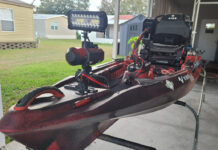I was fishing with my kayak positioned tight to a bridge piling when a guy on a Jet Ski, swerving in and out of the pilings, damn near ran me over. My blood boiled as I calculated how close I had come to an accident. Fishing is supposed to be fun, not frustrating—or deadly. But to improve boating safety will surely take some work from everyone on the water.
Better Boating Safety is Everyone’s Responsibility
It turns out that kayakers aren’t immune from criticism either. A few months after my near-miss with the Jet Ski, I was launching my own motorboat when a kayaker pulled into the only useable ramp and started unloading his boat and gear. “Hey, buddy,” I said with as much diplomacy as I could muster, “you’re blocking the ramp.” His neck swelled and he spit at me, “I was here first!”
No one was at immediate risk of drowning on the boat ramp that day, but the incident illustrates how sometimes we find ourselves at loggerheads to the disadvantage of everyone. Yet, the number of boater and paddler incidents has increased as the popularity of both sports brings more newbies to the water.
Seeking to Find Where We Go Wrong
Exasperated at both my kayaking and boating brothers and sisters, I turned to the experts for some answers. My first call was Jim Emmons at the Water Sports Foundation, a nonprofit dedicated to promoting boater safety. Emmons pointed me to Randy Henry, Oregon’s boating safety program manager.
Henry is most concerned with weekend warriors unfamiliar with the maritime laws and the laws of physics. He says up to 70 percent of annual on-water fatalities are non-motorized boaters. “Most of them are casual users who aren’t prepared for the risk,” Henry says.
So, how do we educate them? Henry points to a wealth of resources. “We have excellent material from American Canoe Association, and links on our website to non-motorized boater education. Check out local paddling clubs, they’re often focused on safety and you’ll learn new places to paddle away from boat traffic.”
Expert Tips for Boating Safety
For a crash course, Henry offers these tips. First, paddle along the side of the river and cross a channel at a right angle. “Priority always goes to the boat that is least maneuverable,” he continues. A kayaker coming down river has little ability to maneuver. “But a jet boat going up the river in five inches of water is literally committed,” he adds.
Another issue is boat wake. “We’ve had plenty of swampings,” Henry says. Even though the powerboater is often held accountable, he says, “Paddlers need to realize there are certain situations they shouldn’t be in.”
Life jackets and sobriety round out Henry’s list of tips for safe interactions. “Several of our non-motorized fatalities last season were due to impairment,” Henry says. He admits the victims were not experienced. “I don’t think they identified themselves as paddlers,” he says.

On a recent patrol, he encountered the problem head on. “Ten percent of people in rented rafts or kayaks were impaired by alcohol or marijuana or both.” He says many people rent or borrow a kayak or only use it a few times a year. “Skill is minimal, they were mostly there to party.”
Still, Henry admits experienced paddlers are also at risk. “There are always a few paddlers who are skilled and just end up in a bad spot,” Henry says. He has one piece of advice for all paddlers. “If everyone would wear a life vest, we would cut our fatalities in half.”
Proper Ramp Etiquette Goes a Long Way
While the focus of paddler and boater safety is on the water, Henry points out many of the negative interactions occur on land. “There is some friction at boat ramps where there is limited space,” he shakes his head. He places the blame on the sharp increase in non-motorized boats at the launch. “It’s mainly an etiquette issue.”
When I asked Kim Jackson, boating safety manager in Arizona, about bad blood between boats and kayaks, launch ramp conflict was the first thing on her mind. “As a community, we need to work on ramp etiquette,” she says.
For Jackson, that means boaters and kayakers prepare their boats away from the ramp. “Load your stuff, then launch the boat and get out of the way,” she instructs.
Both Arizona and Oregon have joined other states in adding non-motorized boat access to their launch facilities. Jackson says funding is an issue because construction money often comes out of federal excise tax on fishing gear and state boater registration fees. The solution is charging kayakers a usage fee or adding a registration tax.
Educate Yourself on Safe Boating Practices
Jackson and Henry stress education as the way to improve relationships. Jackson admits, “So many people are getting into paddling because it’s affordable, they don’t know the rules.” But Henry has the best advice, “Non-motorized boaters have plenty of places to enjoy great paddling away from heavy boat traffic.”
This article was first published in the Winter 2020 issue of Kayak Angler Magazine. Subscribe to Kayak Angler Magazine’s print and digital editions, or browse the archives.
Crossing paths and crossing lines, kayakers and boaters can get along. | Feature photo: Andy Hagedon







Doesn’t the excise tax also apply to kayaks?
I think most do not know or care to know that the Coast Guard has rules of the road that apply to type of vessel, being overtaken, who is more maneuverable. These rules are there for a reason and if followed will resolve many of the issues. Now if your a knot head be it a power boater or a kayak fisherman that is another problem all together.
Seems the issue is that “kayaking” has been diluted to be either elitist to those who claim to be kayakers because they happen to fish out of a boat that is considered a “kayak” or by those who read all the misleading and vague articles on kayaking that dismiss or totally miss the important points on skill levels and safety. RE: the ramp. If you are going to load and launch your kayak, you need to be at water’s edge due to the weight of the gear, etc. Ramps are first come/first serve, not biggest boat over smaller boat. A prudent kayaker should be conscious of the time and those waiting and get their business done quickly, BUT have as much right to use the boat ramp for a judicious amount of time as any other boater.
Well, a very biased article if I say so myself. Powerboats can do no wrong and kayakers are the ones to blame. Horse hockey! I’ve been kayak fishing for 20 years and a spent 35 years working in boats until my retirement from the state wildlife department. You blame the kayakers because they’re “new” to the sport and then you don’t take into account the plethora of people who buy jet skis, bass boats, and ski boats beer up, and go out to party on the water!